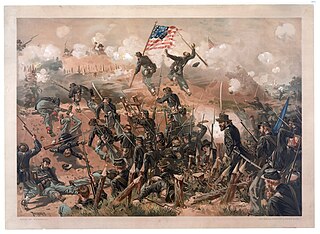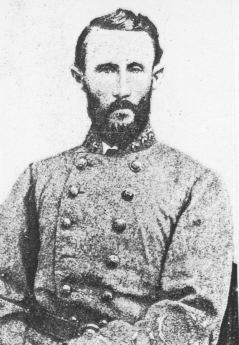
The Siege of Vicksburg was the final major military action in the Vicksburg campaign of the American Civil War. In a series of maneuvers, Union Major General Ulysses S. Grant and his Army of the Tennessee crossed the Mississippi River and drove the Confederate Army of Mississippi, led by Lieutenant General John C. Pemberton, into the defensive lines surrounding the fortress city of Vicksburg, Mississippi, leading to the successful siege and Confederate surrender.

The Battle of Arkansas Post, also known as Battle of Fort Hindman, was fought from January 9 to 11, 1863, near the mouth of the Arkansas River at Arkansas Post, Arkansas, as part of the Vicksburg Campaign of the American Civil War. Confederate forces had constructed a fort known as Fort Hindman near Arkansas Post in late 1862. In December of that year, a Union force under the command of Major-General William T. Sherman left for an expedition against Vicksburg, without Major-General John A. McClernand because neither Major-Generals Henry Halleck nor Ulysses S. Grant trusted McClernand. After Sherman's force was repulsed at Chickasaw Bayou, McClernand arrived and took command from Sherman in January 1863.

The Vicksburg campaign was a series of maneuvers and battles in the Western Theater of the American Civil War directed against Vicksburg, Mississippi, a fortress city that dominated the last Confederate-controlled section of the Mississippi River. The Union Army of the Tennessee under Major General Ulysses S. Grant gained control of the river by capturing this stronghold and defeating Lieutenant General John C. Pemberton's forces stationed there.

The Battle of Cloyd's Mountain was a Union victory in western Virginia on May 9, 1864, that allowed the Union forces to destroy a large bridge on the Virginia and Tennessee Railroad. The railroad was used to carry Confederate troops and supplies, and served important lead and salt mines. It also helped connect the Confederate capital of Richmond with Tennessee, and had telegraph wires along its line for communications. The fight had a high percentage of casualties for both sides, and the Confederate commander, Brigadier General Albert G. Jenkins, was mortally wounded.

The Battle of Secessionville was fought on June 16, 1862, during the American Civil War. Confederate forces defeated the Union's only attempt to capture Charleston, South Carolina, by land. It's noted for the court martial of the Union Brig. Gen. Henry Benham for trying to take James Island, which was against the orders given.

The Battle of Port Gibson was fought between a Union Army commanded by Major General Ulysses S. Grant and a reinforced Confederate States Army division led by Major General John S. Bowen. Though the outnumbered Confederate soldiers fought stubbornly, they were steadily pressed back during the day by Major General John A. McClernand's troops. Bowen eventually conceded the field by withdrawing north toward Vicksburg, Mississippi. The battle occurred near Port Gibson, Mississippi, during the Vicksburg Campaign of the American Civil War.

The Battle of Raymond was fought on May 12, 1863, near Raymond, Mississippi, during the Vicksburg campaign of the American Civil War. Initial Union attempts to capture the strategically important Mississippi River city of Vicksburg failed. Beginning in late April 1863, Union Major General Ulysses S. Grant led another try. After crossing the river into Mississippi and winning the Battle of Port Gibson, Grant began moving east, intending to turn back west and attack Vicksburg. A portion of Grant's army consisting of Major General James B. McPherson's 10,000 to 12,000-man XVII Corps moved northeast towards Raymond. The Confederate commander of Vicksburg, Lieutenant General John C. Pemberton, ordered Brigadier General John Gregg and his 3,000 to 4,000-strong brigade from Jackson to Raymond.

The Battle of Grand Gulf was fought on April 29, 1863, during the American Civil War. Union Army forces commanded by Major General Ulysses S. Grant had failed several times to bypass or capture the Confederate-held city of Vicksburg, Mississippi, during the Vicksburg campaign. Grant decided to move his army south of Vicksburg, cross the Mississippi River, and then advance on the city. A Confederate division under Brigadier General John S. Bowen prepared defenses—Forts Wade and Cobun—at Grand Gulf, Mississippi, south of Vicksburg. To clear the way for a Union crossing, seven Union Navy ironclad warships from the Mississippi Squadron commanded by Admiral David Dixon Porter bombarded the Confederate defenses at Grand Gulf on April 29. Union fire silenced Fort Wade and killed its commander, but the overall Confederate position held. Grant decided to cross the river elsewhere.
This is a list of Confederate government Civil War military units, not raised by any state.
The following Union Army units and commanders fought in the Siege of Vicksburg of the American Civil War. The Confederate order of battle is listed separately. Order of battle compiled from the army organization during the campaign.
Galvanized Yankees was a term from the American Civil War denoting former Confederate prisoners of war who swore allegiance to the United States and joined the Union Army. Approximately 5,600 former Confederate soldiers enlisted in the United States Volunteers, organized into six regiments of infantry between January 1864 and November 1866. Of those, more than 250 had begun their service as Union soldiers, were captured in battle, then enlisted in prison to join a regiment of the Confederate States Army. They surrendered to Union forces in December 1864 and were held by the United States as deserters, but were saved from prosecution by being enlisted in the 5th and 6th U.S. Volunteers. An additional 800 former Confederates served in volunteer regiments raised by the states, forming ten companies. Four of those companies saw combat in the Western Theater against the Confederate Army, two served on the western frontier, and one became an independent company of U.S. Volunteers, serving in Minnesota.
The 21st Iowa Infantry Regiment was an infantry regiment that served in the Union Army during the American Civil War.
The Pointe Coupee Artillery was a Confederate Louisiana artillery unit in the American Civil War made up primarily of men from the parishes of Pointe Coupee, East Baton Rouge, Livingston and other surrounding parishes as well as a large number of men from New Orleans.
Hispanics in the American Civil War fought on both the Union and Confederate sides of the conflict. Not all the Hispanics who fought in the American Civil War were "Hispanic Americans" — in other words citizens of the United States. Many of them were Spanish subjects or nationals from countries in the Caribbean, Central and South America. Some were born in what later became a U.S. territory and therefore did not have the right to U.S. citizenship. It is estimated that approximately 3,500 Hispanics, mostly Mexican-Americans, Puerto Ricans and Cubans living in the United States joined the war: 2,500 for the Confederacy and 1,000 for the Union. This number increased to 10,000 by the end of the war.

Thomas Neville Waul was a Confederate States Army brigadier general during the American Civil War. Before the Civil War, he was a teacher, lawyer, judge and planter. He served for a year in the Provisional Confederate Congress from Texas. He was captured at the fall of Vicksburg, Mississippi, on July 4, 1863, and exchanged in October 1863. After his promotion, Waul served in the Confederate Trans-Mississippi Department. He was wounded at the Battle of Jenkins' Ferry. After the Civil War, Waul was a farmer and lawyer who lived in Texas until his death at age 90.
The 1st Arkansas Cavalry Battalion (Stirman's) (1864–1865) was a Confederate Army cavalry battalion during the American Civil War. The unit was also known as Brooks 1st Arkansas Cavalry Battalion, Stirman's, 1st Arkansas Cavalry Battalion, Stirman's Sharpshooter Regiment, 1st Regiment Arkansas Sharpshooters, and finally simply as Stirman's Arkansas Cavalry Regiment.

The Battle of Ponchatoula was a battle in Ponchatoula, Louisiana, and Ponchatoula Creek at the onset of the Vicksburg Campaign during the American Civil War. Fought from March 24 to March 26, 1863, the battle was part of an offensive campaign waged by the Union's 6th Michigan, 9th Connecticut, 14th Maine, 24th Maine, 165th New York Zouaves, and 77th New York infantry against Confederate troops to capture Ponchatoula for the Union and destroy the town's railroad bridge. This was ultimately a failure by the Union, as the outcome of the battle led to the Confederates regaining control of Ponchatoula.

1st Texas Field Battery or Edgar's Company was an artillery battery from Texas that served in the Confederate States Army during the American Civil War. The artillery company formed in November 1860, but was not formally taken into Confederate service until April 1861. The unit participated in the disarming and surrender of United States soldiers and property in Texas in early 1861. The battery marched to Arkansas where in 1862 it joined the infantry division known as Walker's Greyhounds. The battery fought at Milliken's Bend and Richmond (La.), shelled a Federal river transport, and campaigned in south Louisiana in late 1863. The 1st Texas Battery was captured at Henderson's Hill in March 1864. The soldiers were later exchanged, and the unit disbanded in 1865 at the end of the conflict.

The 8th Texas Infantry Regiment was a unit of volunteers recruited in Texas that fought in the Confederate States Army during the American Civil War. In May 1862, the 8th Texas Infantry Battalion mustered into Confederate service in Refugio County, Texas, with three companies. A fourth company joined in June 1862 and a fifth company soon afterward. After training at Banquete, Texas, until July 1862, the battalion fought in the Battle of Corpus Christi where it defended that city. The full regiment was created when the 8th Infantry Battalion was joined by Shea's Artillery battalion, making 1 cavalry, 5 infantry, and 4 artillery companies. The regiment fought at Fort Esperanza in November 1863 and was transferred to east Texas soon afterward. At this time, many soldiers from the 8th Infantry transferred to Waul's Legion and fought in the Red River campaign. The regiment mustered out of service on 22 May 1865.















